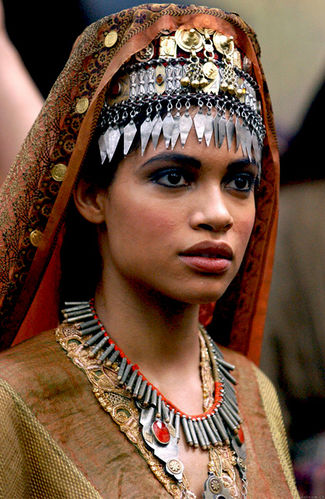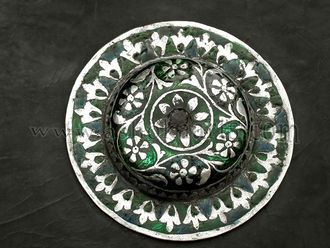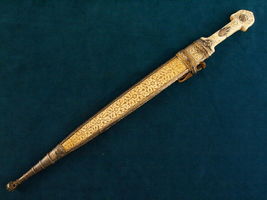The Brass Coast look and feel
m (→Weapons) |
|||
| Line 96: | Line 96: | ||
</row-fluid> | </row-fluid> | ||
==Things to | ==Things you're unlikely to see== | ||
* The Corsairs are not classic fantasy pirates - you're unlikely to see a lot of bandanas, cutlasses and scimitars on The Brass Coast | |||
* Whilst the inspiration comes from cultures with strong Arabic influences, The Brass Coast is not an Islamic or stereotyped contemporary Arabic culture. Shemagh and agal (the classic white patterned headdress with band) don't fit the look, neither do Sartorial Hijab (garments which cover hair or body for modesty reasons) nor does a Fez. Even turbans are not standard wear. Instead the Brass Coast favours scarves tied in a style known as the Tagelmust. | |||
* Although there are no particular modesty taboos, dancers tend to be far more interested in showing off how they can make fabrics flare and move than displaying their own flesh. Belly dancing is not a common Freeborn pursuit. | |||
The | |||
not | |||
Revision as of 12:05, 7 November 2012
Overview
The Freeborn look is one of bright colours, silks, jewels, and sumptuousness. They admire ornate or bejewelled items. To the Freeborn, a brilliant craftsman is one who can make something elegant as well as sturdy. Their weapons and armour are often engraved or adorned, but they are not fatuous, and do not compromise utility for the sake of appearance. Jewellery is very common with the best pieces, like necklaces, crowns or tiaras, designed to frame the wearer's hands or face.
The image of the flame is central to the Freeborn culture; they believe it represents their spirit: wild, powerful and unchained.
Also see Brass Coast Costumes and Brass Coast Icons and Artistry.
Breakdown
Influences
The traditional looks of Moorish Spain, Morocco, Algeria, Tunisia.
Feel
Free, flowing, headstrong, sumptuous, practical, exuberant, hedonistic, colourful, rich, joyful.
Materials
Lightweight fabrics such as voiles and chiffons, either silk or synthetic. Also silks, brocades and other rich fabrics. Leather is considered unappealing for clothing, it’s a heavy material they reserve for boots and armour. Gold is prized over silver where available.
Colours
Bright, vibrant colours, especially the colours of flames: strong bright yellows, brilliant oranges and every conceivable shade of red as well as gold and silver. Expensive clothing is made in brightly coloured layers to convey the impression of the fire within.
Avoid Black or White. Black is considered severe and used for shrouds to wrap the dead. White is the colour of the poor, of those too impoverished to afford exotic dyes.
Clothing
Veils, scarves, head-wraps, pantaloons, loose shirts and kaftans, sashes rather than belts. Clothing is usually worn loose with layers of draped material.
Veils are worn by men and women to make them appear more mysterious and alluring. The ideal style is the tagelmust (preferably in bright red, orange or yellow rather than blue).
Clothing and headdresses will often be decorated with shiny metal jewellery, bells, coins and other jingly bits. Jewelry should frame the hands and face.
Ideally scabbards or pouches should hang at the waist by a silk cord that goes over the shoulder. Any tattoos should be highly intricate, henna-style.
Jewellery and veils
Jewellery should frame the face or hands to draw attention to them. Veils are fashionable for men and women who wish to appear mysterious and alluring.
Scale armour
Scale is the ideal armour, ideally in a bright golden colour, worn like mail or else secured with leather.
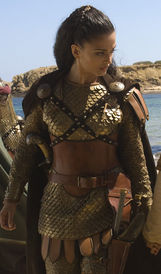
Mail armour
Mail in the jannissary style, particularly the chain helmets, is also great. Small pieces of plate or breastplates are good especially if ornate and inlaid. Armour, whether metal or leather, should have embellished edges and rich decoration, with calligraphy and ornate designs.
Shields
The Freeborn favour round (ideally domed) metal shields, highly decorated if possible. Gold inlay and engraving are both particularly popular.
Weapons
Scimitars are less common than straight swords and axes which are the preferred weapons. The Bhuj, a large heavy single-bladed spear, is the ideal pole-arm. The best quality weapons are intricately etched and engraved with complex designs.
Corsairs
Corsairs epitomize Freeborn daring and adventure. Javelins and bows are common but the Catazarri crossbow is also used. Many are lightly armoured, but the most bold show off their success with ornately gilded plate.
Children
Children are an opportunity for parents to show off their wealth, dressing their offspring in traditional Freeborn styles.
Sutannir
Sutannir often paint their faces and skin with designs inspired by flames and themes of fire.
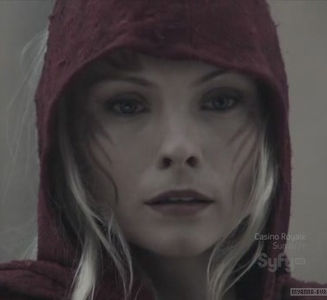
Things you're unlikely to see
- The Corsairs are not classic fantasy pirates - you're unlikely to see a lot of bandanas, cutlasses and scimitars on The Brass Coast
- Whilst the inspiration comes from cultures with strong Arabic influences, The Brass Coast is not an Islamic or stereotyped contemporary Arabic culture. Shemagh and agal (the classic white patterned headdress with band) don't fit the look, neither do Sartorial Hijab (garments which cover hair or body for modesty reasons) nor does a Fez. Even turbans are not standard wear. Instead the Brass Coast favours scarves tied in a style known as the Tagelmust.
- Although there are no particular modesty taboos, dancers tend to be far more interested in showing off how they can make fabrics flare and move than displaying their own flesh. Belly dancing is not a common Freeborn pursuit.
